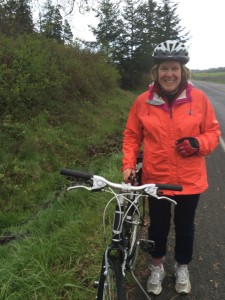

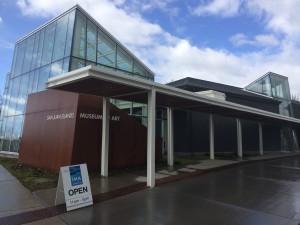
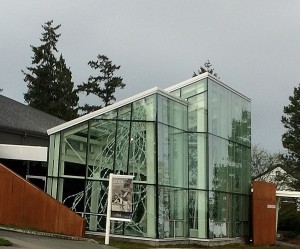
What a surprise to discover a beautiful new venue for contemporary art in Friday Harbor on San Juan Island. The San Juan Islands Museum of Art has existed in temporary venues for several years, but it moved into its current re purposed building a year ago, and hired a dynamic young director, Ian Boyden, 8 months ago.
Not only is this a wonderfully intimate museum space, but Boyden just created a provocative three part installation that included Ai Wei Wei, and Goya both addressing the devastating cruelty of bureaucracy, governments, and soldiers. The third part of the installation by Dana Lynn Louis suggests moving the dark feelings from the other two exhibitions out into air and space.
Ai Wei Wei’s installation “Fault Line” is what brought me to Friday Harbor.
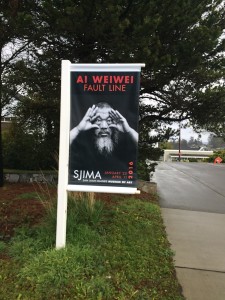
Following his dazzling and moving installation on Alcatraz Island last year calling attention to the identity of dozens of political prisoners detained all over the world, Ai Wei Wei has continued to have exhibitions which he has organized from China while he was under house arrest and unable to travel outside the country from 2011 to July 2015.
His strategies for making the invisible visible continues in this exhibition on a theme that he has addressed frequently: the death of over 5000 children in the Wenchuan earthquake of 2008.
In this presentation, the list of names fills two walls of the museum, here you see the director in front of the list and, below, a detail of the last part of the list which ends with no 5196, Zhu Guiying a girl born in 1990. Each year on the child’s birthdays Ai Wei Wei posts on his twitter feed to honor that child.
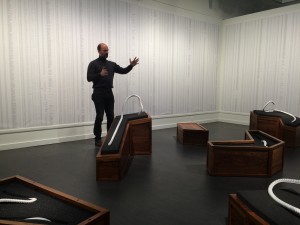
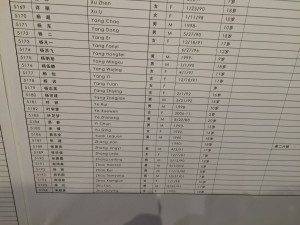
Behind a partition, the video “Little Girl’s Cheek” 2008 interviewed the parents of the children who died in the collapsed schools. Ai Wei Wei hired researchers to gather the information.The parents, relatives and friends tried digging out the rubble covering the still living children with their bare hands when no help arrived. It is unimaginably painful to hear them describe the cries of the children.
The soldiers stood by doing nothing. When the parents protested they were barred from the site. When they went to officials they did nothing, explained nothing. The government harrassed the investigators that Ai WeiWei had hired. The parents were mostly peasants who had sacrificed everything for their children’s education and now had only a tragedy.
The officials blamed the earthquake for the collapse of the dozens of schools, but the shabby construction was clearly to blame.
In other installations by Ai Wei Wei on the subject of the children lost in the earthquake we have seen hundreds of backpacks, or piles of the rebar that collapsed. Ai Wei Wei bought tons of it and straightened it.
Here, we have shapes evoking coffins.
There are 8 coffin like forms made of rosewood, that seem like enlarged jewelry cases with black foam holding pieces of rebar carved in marble that seem to rise up from their containers like ghosts coming back to haunt us. “Rebar and Case” (2014) has not been shown in a museum before.
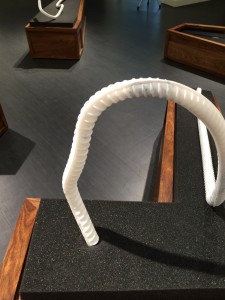
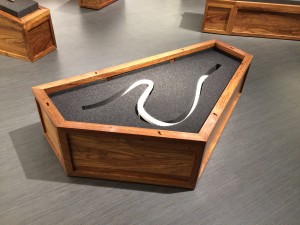
The juxtaposition of these three ways of representing the disaster overwhelmed me with the tragedy in a way that I had not been affected by previous installations. Part of the reason was the intimacy of the space in this small museum, where we walked between the coffin forms and looked down on the ghost rebars, thinking of the children buried still under rubble, most of them never properly recovered and given a funeral. Here was a graveyard of lost children, with unmarked graves.
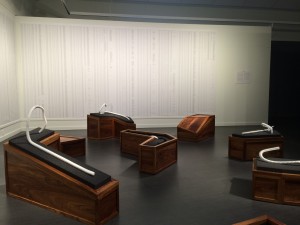
In partnership with this installation was the gallery of Goya prints with the title print on a poster “The Sleep of Reason Produces Monsters.”
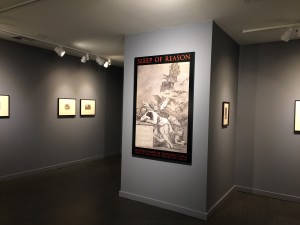
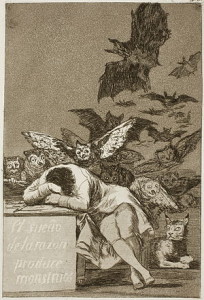
What could be a more appropriate partner to “Fault Line” than Goya’s Caprichos, that sarcastic representation of the inhumanity of the bourgeoisie aristocracy and the clergy toward the poor.
No 79 Nada Nos ha visto (No One has Seen us) 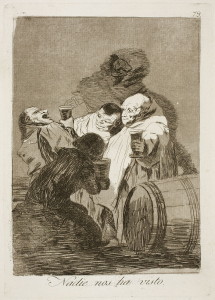 Pobrecitas ( Poor Little Girls)
Pobrecitas ( Poor Little Girls)
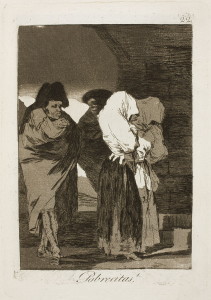
“Yo es Hora” Capricios no. 80 ( It is Time).
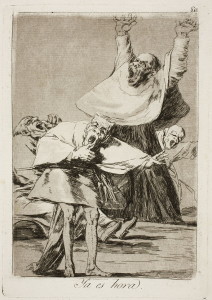
\
Relieving us from this immersion in the wicked ways of the power elite, we enter into the installation of Dana Lynn Louis “As Above, So Below,” It is a site specific installation for the atrium of the museum, a space that resembles a greenhouse with its glassed in walls. Louis’s installation glass and mixed media sculptures change constantly according to light and weather conditions, time of day, or our own moods. It follow on her “clearing project,” which asked people all over thew world to “clear” themselves either spiritually or physically, but writing down these wishes and intentions on a piece of paper that was then burned.
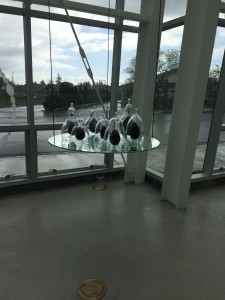
Here we sense a different type of clearing, a more immediate clearing of the darkness of the other two parts of the installation with the lightness, both literally and metaphorically, of the suspended glass sculpture.
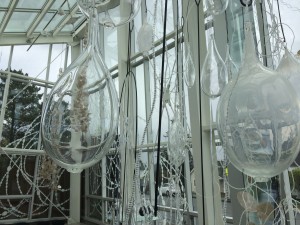
Ian Boyden is a great addition to our Northwest contemporary art scene. He is engaged and thoughtful, dynamic and motivated. Keep your eye on this museum for future exciting installations. UPcomin April 23 is Fragile Waters: Ansel Adams, Ernest H. Brooks II and Dorothy Kerper Monnelly,” until September 5. It will open on Earth Day.
Clearly this museum is going to be on our itinerary! You can combine your art visit with renting a bike and Island Bicycles.